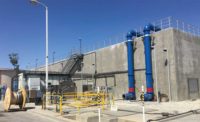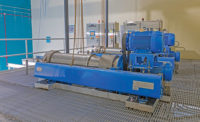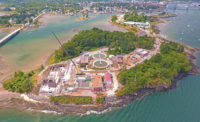Terminal Island Water Reclamation Plant Advanced Water Purification Facility Expansion
Los Angeles
Best Project
Owner: LA Sanitation
Design Firm/Civil/Structural/MEP Engineer: Bureau of Engineering-Environmental Engineering Division
General Contractor: Walsh Construction Co. LLC
Project Engineer: Carollo Engineers Inc.
Los Angeles Sanitation has built what the Bureau of Engineering calls one of the world’s most technologically advanced water treatment systems at the Terminal Island Water Reclamation Plant. The new facility also doubles the plant’s capacity, providing up to 12 million gallons per day of recycled water.
The utility will use a portion of that amount to shield the local groundwater system from seawater intrusion and use the rest for irrigation, industrial uses and to augment a nearby lake.
The facility’s oxidation process is the first of its kind in the world and uses ultraviolet light and chlorine bleach to purify the water. This method was selected after a year-long pilot study at the Terminal Island Plant found it less expensive and more environmentally friendly than the traditional oxidation process using hydrogen peroxide. It also eliminates the need to pull leftover hydrogen peroxide from the water after treatment.
The new process required a facility for the UV light system as well as a 2-million-gallon equalization tank, says Adam Zacheis, vice president at Carollo Engineers Inc. and the project’s engineer of record and design team project manager.
“The biggest challenge is that it’s a very tight space,” Zacheis says. “The microfiltration, the RO (reverse osmosis) and the reactors are pretty much crammed into that small site. There were challenges running utilities; we kept finding buried utilities that weren’t supposed to be where they were.”
Contractors built the facility at the Terminal Island plant’s 21-acre site using a modular design, with the modules fabricated off site in a safer, more controlled environment. Site and foundation work could be completed at the same time as module fabrication, and the modules arrived at the site pre-assembled, tested and electrically wired.
The first two treatment steps for advanced purification are microfiltration (where water is filtered through tubes filled with tiny plastic straws) and reverse osmosis (where water is pushed through plastic membranes to filter out molecule-size salts and pharmaceuticals). The project team built canopies with perforated stainless-steel panels to protect the microfiltration and reverse-osmosis modules from sun and rain.
Any impurities remaining in the water are treated by Terminal Island’s UV reactor. The intense UV light inside the reactor creates “radicals,” or groups of atoms, that attack any remaining organic material.
Advanced water purification is a fast-growing field, says Zacheis, with applications including supplying purified water for industrial, irrigation and other uses and protecting natural freshwater reserves. Eight potable water reuse projects are operating in California, with about 22 more planned in the state.
“These kinds of plants are only increasing in number,” Zacheis says. “There are so many being planned all over the country.”
Related Article: Communities Are the Real Winners






Post a comment to this article
Report Abusive Comment